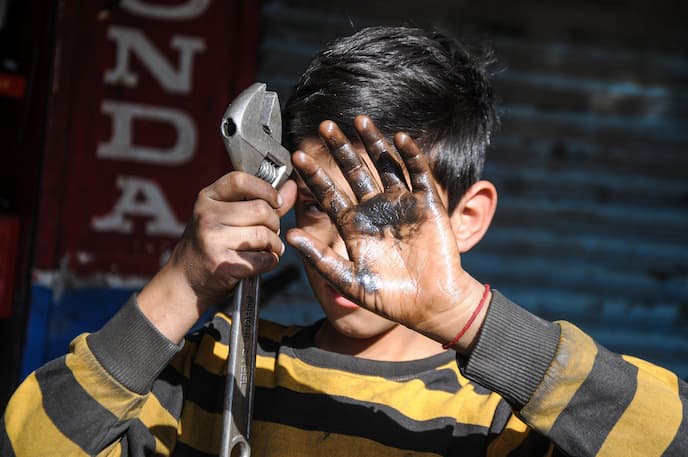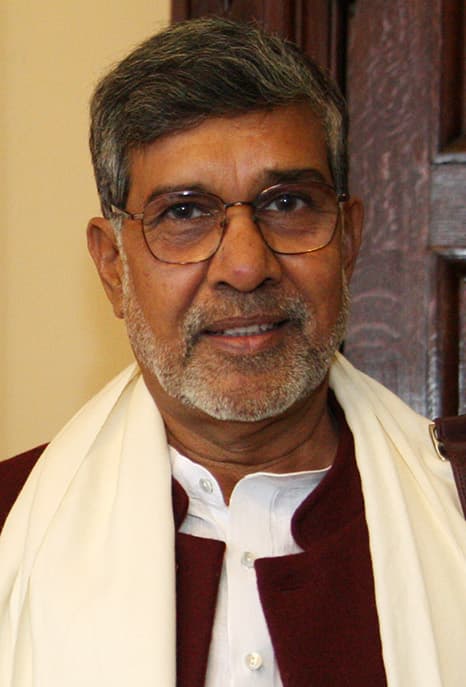Set Our Children Free
The chapter Set Our Children Free is the famous speech delivered by Kailash Satyarthi. In the speech he describes the brutal realities of the children whose dreams and hopes are taken away. All you need to know and learn about this chapter is given below.
Meet the Author
- Kailash Satyarthi won the Nobel Peace Prize Winner in 2014 along with Malala Yousafzai for working and fighting for children’s right to education and freedom.
- Born: 11 January 1954
- Place of Birth: Vidisha, India
- Best known for: He is an Indian social reformer. He is the founder of ‘Bachpan Bachao Andolan’. He continues to work for children’s rights and the betterment of the downtrodden for many years.
Read and learn more from Kailash Satyarthi through his book Every Child Matters.

Share Options
Summary of the Chapter
Set Our Children Free is the Nobel speech delivered by Kailash Satyarthi. He begins his speech by addressing all the dignitaries, viewers and other guests in the audience.
He opens the speech by calling himself the representative of the ‘sound of silence’. He is representing the ‘face of invisibility’ and the ‘cry of innocence’. Kailash Satyarthi has come there as a representative of millions of children who are left behind. The empty chair was a reminder for the millions of children who have lost their dreams and hopes in this world.
He considered himself to be the voice to the dreams of those who lost their childhood and hopes. He then goes on to recollect an instance from his memory. 20 years ago at the foothills of the Himalayas he happened to meet a small skinny child labour. This small boy asked a question that haunted Kailash Satyarthi for years and he posted that question to the audience.
Is the world so poor that it cannot give me a toy and a book instead of forcing me to take a gun or a tool.
He continues his speech with anecdotes from his experience with children across the world. 12 years ago a child mother from the streets of Columbia asked him,
I have never had a dream. Can my child have one?
Through these two anecdotes he is opening up a larger picture of child labour and human trafficking. He is standing there with the lost dreams of millions of children who were forced into labor and other illegal activities during their childhood.
Soon in the speech he goes onto quote from the holy Bible,
Let the children come to me, do not hinder them for the kingdom of God belongs to them.
According to Jesus, as mentioned in the Bible children are the most pure and blessed souls on the planet. By quoting the words of Jesus Satyarthi is trying to remind the audience the value and virtues of kids.

Satyarthi then goes on to quote from the holy Quran,
Kill not your children because of poverty.
The holy Quran is asking to not punish the children for poverty or any other reason caused by us. The holy book is reminding us to protect and take care of them.
For Satyarthi, there is no greater violence than to deny the dreams of children. Hence, he refuses to accept that all the temples and mosques and prayer houses have no place for the dreams of the children. According to him, if we can build a mosque, temple, church or any other house for prayer we need to give equal importance to the dreams of the children. Children’s future must also hold an equal importance in the world like the large prayer homes.
He refused to accept that the world is so poor to feed the children because he understands that one week of global military expenditure can bring all the children into classrooms. The money spent on military expenses across the world in a week can help gather children to gain education.
He refused to accept that no law, constitutions, police or judges could protect our children. These laws and offices are built to ensure child safety and if they are not able to function properly then the whole idea of having an institution becomes meaningless.
He also refused to accept that the shackles of slavery can never be stronger than the quest for freedom. Satyarthi strongly believed and refused to accept the fact that the change and the unbreakable tangles of slavery is stronger than the need for freedom. He is advocating for freedom and to break off from the chains of slavery to set the children free.
He then goes onto explain his aim in life. His aim in life is to ensure that every child born in this world grows, eats, sleeps, develops and sees daylight. His aspiration is to ensure that every child loves, cries, dreams, learns and goes to school. He aims for a world in which every child can have a dream.
He carries on to say that he was privileged to work with many courageous people who have the same aim. They are never willing to stop or return back even if that means they have to sacrifice their own life. They are not scared of the threats or attacks because they believe strongly in their aim and the need for change.
We have never given up against any threat or attack and we never will.
According to Satyarthi the biggest challenge or the crisis that is knocking at us is fear and intolerance. Fear and intolerance will help the injustice and violence against children grow and not help bring in change.
He soon goes on to call Malala, Kayanats and Shazia as his own daughters. They are all victims of violence. They all stood for the right for a child to have a dream and education. He goes on to point out that all these brave people have chosen peace over violence, tolerance over extremism, and courage over fear.
Satyarthi is not disappointed completely; he sees a ray of hope. He believes that the solutions will not be found in conference rooms or as prescriptions from a distance from the actual issue. Only when one gets into the matter and understands the complexities of the issues can solutions arrive.
Satyarthi then moves to narrate a story to explain how even one tiny contribution can change the world. The story goes like this; heavy fire breaks out in the forest and every animal including the lion, the king of the forest, decides to run away. Lion then spots a small bird trying to extinguish the fire with a little drop of water in its beak. Lion laughs at the bird and mocks her for her stupidity. But the bird was very adamant and she stood her ground by stating that she wanted to do her bit.
The lion laughed and said, “Wow, can you do it keeping just one drop of water in your beak?”
Immediately he goes on to remind his listeners that we are living through an age of rapid globalization. With the help of high speed internet, the goods services and flights that connect one corner of the world and another, a lot of changes are possible. But there is a lack of compassion.

Share Options
He believes that only compassion for each other can change the world. Global compassion is the only way forward. He then quotes Mahatma Gandhi and says,
If we are to teach real peace in this world we shall have to begin with children.
He then posted a series of questions which as listeners we all have to answer.
- Whose children are they who stitch football boots that have never played with one?
- Whose children are they who harvest cocoa yet have never tasted chocolate?
- Whose children are they who are dying of ebola?
- Whose children are they who are kidnapped and held hostage?
All these rhetorical questions have a simple answer, they are our children.
The children who goes through inequality, child labour, humsn trafficking and diseases are all the children of the world who has to contribute to make this world a better one.
He then remembers another question asked by an 8 year old girl who was rescued from forced labor at a stone quarry,
Why did you not come earlier?
Her anger shook him and gave him a sense of urgency. Every single minute matters, every single child matters, every single childhood matters.
Therefore he goes on to challenge the passive and lazy attitude shown toward the issues of children. He then challenged the silence shown by the society and the leaders and the neutral steps that they have taken towards rescuing and offering these children a better future. He wanted everyone to be ambitious and keep their promises.
50 years ago on his first day at school he saw a cobbler boy sitting outside the school. He asked his teachers why that boy was working outside the school and not attending the classes. The teacher had no answer. He then gathered the courage to ask the boy's father to find out the reason.
And the father replied,
Sir, I have never thought about it. We are born to work.
This answer made Satyarthi extremely angry. From that day onwards he made his vision. He wanted that cobbler boy to sit with him in the same classroom. He then goes on to urge the audience to remember to offer a right to life, the right to education, the right to freedom, right to safety, right to dignity and the right to equality and the right to peace.
Kiran later goes on to conclude his speech by stating the fact that he is saying more smiling and happy faces and the hope in the eyes of the children today. He wants everyone to feel and see this joy. He sees thousands of Mahatma Gandhis, Martin Luther kings and Nelson Mandela calling on us.
His aim is now to democratize knowledge and universalized justice. He wants knowledge to be given to everyone irrespective of their caste, creed, color, race or age. He wants to universalize justice and give everyone an equal chance and opportunity. He wants all to show and experience global compassion, love and kindness for each other.
He is calling everyone to march so that we move from exploitation to education, poverty to shared prosperity, slavery to liberation and from violence to peace.
He concludes with a Sanskrit slogan which goes like,
Let us March from ignorance to awakening
Let us March from darkness to light
Let us March from mortality to divinity.
The crux of his speech being a first hand experience of the ground reality and the need for collective action from each and every part of the country.
Share Options
Bonus Info
Malala Yousafzai
Malala Yousafzai is a Pakistani activist who works for female education. She was shot by the Taliban when she stood her ground for her education in Pakistan. She is now a graduate from Oxford University. She won the Nobel Peace Prize along with Kailash Satyarthi.
Nobel Peace Prize
A Nobel Peace Prize is given to a person who has contributed the most for the peace and harmony among the nations. They promote and work to abolish inequality in the world.
Above and Beyond the Text
Young children like Malala are an inspiration for the younger kids. We highly recommend reading and learning more about such motivational figures. Their life stories and experience can be a great inspiration for the young minds.
I am Malala
The autobiography of Malala is a must read for young minds. The book will inspire you to stand for justice and make a difference in the world.
Redrawing India: The Teach For India Story
Shaheen Mistry’s tale on educating the young minds from the slums of Mumbai is a story to learn and take inspiration from. She has completely restructured education in the underprivileged sector of India.
Get Personalized Tuitions
We offer premium education on a personalized level. Online tuition for all grades, tailor-made!

Set Our Children Free Questions and Answers
Below are a few questions that you can look out for your examinations and class tests. Stand out with perfectly written answers with help of Aneetta Class.
20 years ago he met a skinny child laborer who came to him and asked if the world was so poor to not offer an education. The child labor had to take up guns and work to feed himself. He was uneducated and worked at a young age. This reality made Satyarthi realize the need to work and fight for them.
Kailash Satyarthi is using this oxymoronic expression to signify that there are millions of children whom we cannot see or hear otherwise. Through this expression he is trying to voice and bring their feelings and issues to the world.
Through the story Satyarthi is trying to make us understand that each and every tiny step matters. It is bound to make a difference in the world.